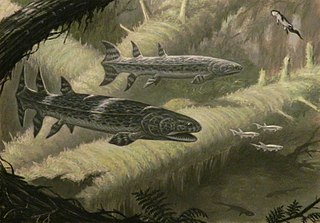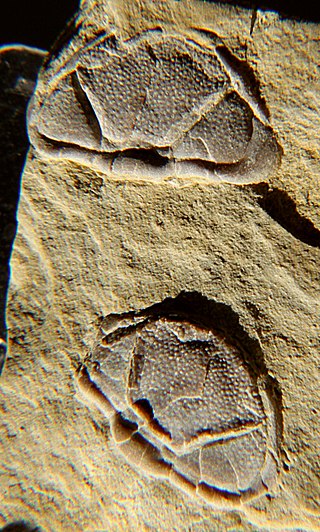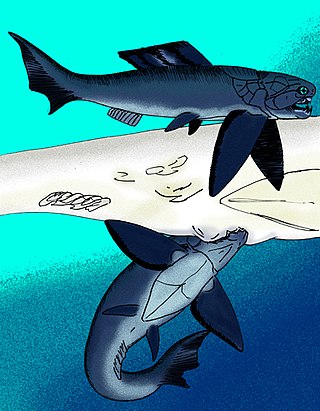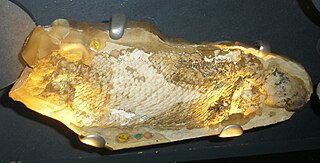
Dunkleosteus is an extinct genus of large arthrodire ("jointed-neck") fish that existed during the Late Devonian period, about 382–358 million years ago. It was a pelagic fish inhabiting open waters, and one of the first apex predators of any ecosystem.

Hyneria is a genus of large prehistoric predatory lobe-finned fish which lived in fresh water during the Famennian stage of the Devonian period.

Stromatoporoidea is an extinct clade of sea sponges common in the fossil record from the Middle Ordovician to the Late Devonian. They can be characterized by their densely layered calcite skeletons lacking spicules. Stromatoporoids were among the most abundant and important reef-builders of their time, living close together in flat biostromes or elevated bioherms on soft tropical carbonate platforms.

Ventastega is an extinct genus of stem tetrapod that lived during the Upper Fammenian of the Late Devonian, approximately 372.2 to 358.9 million years ago. Only one species is known that belongs in the genus, Ventastega curonica, which was described in 1996 after fossils were discovered in 1933 and mistakenly associated with a fish called Polyplocodus wenjukovi. ‘Curonica’ in the species name refers to Curonia, the Latin name for Kurzeme, a region in western Latvia. Ventastega curonica was discovered in two localities in Latvia, and was the first stem tetrapod described in Latvia along with being only the 4th Devonian tetrapodomorph known at the time of description. Based on the morphology of both cranial and post-cranial elements discovered, Ventastega is more primitive than other Devonian tetrapodomorphs including Acanthostega and Ichthyostega, and helps further understanding of the fish-tetrapod transition.

Trimerocephalus is a genus of eyeless trilobites from the order Phacopida, family Phacopidae. It lived during the final stage of the Devonian, the Famennian, and became extinct at the end of this stage, together with all other trilobites with the exception of some Proetida. It can be found in Australia, the Czech Republic, France, Germany, Iran, Kazakhstan, Morocco, Poland, the Russian Federation (Urals), Spain, and the United Kingdom (England).

Dinichthys is an extinct monospecific genus of large marine arthrodire placoderm from the Late Devonian measuring around 3 metres (9.8 ft) long. Fossils were recovered from the Ohio Shale Formation along the Olentangy River in Delaware County, Ohio.

Onychodus is a genus of prehistoric lobe-finned fish which lived during the Devonian Period. It is one of the best known of the group of onychodontiform fishes. Scattered fossil teeth of Onychodus were first described from Ohio in 1857 by John Strong Newberry. Other species were found in Australia, England, Norway and Germany showing that it had a widespread range.

Edward B. 'Ted' Daeschler is an American vertebrate paleontologist and Associate Curator and Chair of Vertebrate Biology at the Academy of Natural Sciences in Philadelphia. He is a specialist in fish paleontology, especially in the Late Devonian, and in the development of the first limbed vertebrates. He is the discoverer of the transitional fossil tetrapod Hynerpeton bassetti, and a Devonian fish-like specimen of Sauripterus taylori with fingerlike appendages, and was also part of a team of researchers that discovered the transitional fossil Tiktaalik.

Eusthenodon is an extinct genus of tristichopterid tetrapodomorphs from the Late Devonian period, ranging between 383 and 359 million years ago. They are well known for being a cosmopolitan genus with remains being recovered from East Greenland, Australia, Central Russia, South Africa, Pennsylvania, and Belgium. Compared to the other closely related genera of the Tristichopteridae clade, Eusthenodon was one of the largest lobe-finned fishes and among the most derived tristichopterids alongside its close relatives Cabonnichthys and Mandageria.

Megalichthys is a genus of prehistoric lobe-finned fish which lived during the Devonian and Carboniferous periods. It is the type genus of the family Megalichthyidae. The type species is M. hibberti. The species M. mullisoni, named for fossil preparator C Frederick Mullison, is known from the Catskill Formation of Pennsylvania.

Chirodipterus is an extinct genus of marine lungfish which lived during the Devonian period. Fossils have been found worldwide, including Germany, China, eastern & western Australia, and the United States (Michigan). However, it has been suggested that the genus as currently defined is polyphyletic, in which case only the German type species would belong to the genus.
Chrysolepis is a genus of prehistoric marine lobe-finned fish that lived during the Late Devonian period. It contains a single species, C. orlensis, known from the middle Famennian of Oryol Oblast, Russia. It is the only member of the family Chrysolepididae, erected due to its highly distinct morphology unseen among other osteolepiforms. It may be the sister taxon to the eusthenopterids.

Holdenius is an extinct genus of arthrodire placoderm fish which lived during the Late Devonian period.

Langlieria is a genus of prehistoric sarcopterygian, from the end of the Devonian period (Famennian). It was discovered in Belgium and Pennsylvania.

The Waterloo Farm lagerstätte is a Famennian lagerstätte in South Africa that constitutes the only known record of a near-polar Devonian coastal ecosystem.
Acondylacanthus is an extinct genus of ctenacanthiform from the Paleozoic era. The type species is A.gracilis. Most species are known from the Carboniferous of America and the British isles. A. jaekeli is known from the upper Frasnian of Germany and the Upper Famennian of Russia. This genus is based entirely upon isolated dorsal fin spines, and thus may later be found synonymous with tooth-based genera. Many species have been ascribed to this genus, though there has been some confusion with Ctenachanthus. This genus is in need of review and research.

Isityumzi mlomomde is fossil lungfish described from fragmentary remains including one complete parasphenoid, tooth plates fragments and scales from the Late Devonian Sarcopterygians. It represents the only record of Late Devonian lungfish remains from western Gondwana.

Phoebodus is an extinct genus of phoebodontiform total group elasmobranch, known from over a dozen species found worldwide spanning the middle to late Devonian, making it one of the oldest known total group elasmobranchs. Most species are only known from their isolated tricuspid teeth, but one species, Phoebodus saidselachus from the Late Devonian of Morocco, is known from a complete skeleton, estimated to have been 1.2 metres (3.9 ft) in total length in life, which shows that it had a slender body superficially similar to that of the living frilled shark. The teeth of Phoebodus and frilled sharks are also morphologically similar, and are designed for grasping prey. Phoebodus probably consumed small prey items that were capable of being swallowed whole.
Labechiida is an extinct order of stromatoporoid sponges. They lived from the Early Ordovician to the Late Devonian, though a few putative fossils have been reported from younger sediments. Labechiids were the first order of stromatoporoids to appear and were probably ancestral to all other orders in the main Paleozoic radiation. They were most diverse and abundant during the Middle-Late Ordovician and the Famennian, when they were a major group of reef-building sponges. However, they were relatively uncommon through most of the Silurian and Devonian, in contrast to other stromatoporoids.

















